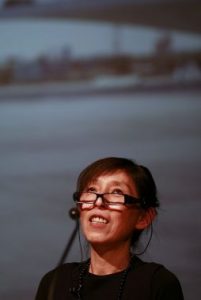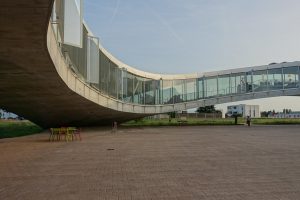Kazuyo Sejima (born 29 October 1956) is a Japanese architect known for being the founder of SANAA, the Tokyo architecture studio that has designed innovative buildings in Japan and around the world.

Image source: https://it.wikipedia.org/wiki/Kazuyo_Sejima#/media/File:Kazuyo_Sejima_mg_4973-small.jpg
Early Years and the Foundation of the SANAA
Sejima was born on 29 October 1956 at Mito, Ibaraki, Japan. She graduated from Japan Women’s University in 1979. She then went on to complete the Master’s Degree course in architecture in 1981.
After apprenticing with Toyo Ito – a Japanese architect known for creating conceptual architecture -, Sejima established the KazuyoSejima& Associates in 1987. One of her first hires was Ryue Nishizawa, a former co-worker, with whom she founded the Tokyo-based firm SANAA (Sejima and Nishizawa and Associates) in 1995.
In 2010, Sejima was appointed director of the architecture sector for the Venice Biennale, which she curated for the 12th Annual International Architecture Exhibition. She was the first woman ever selected for this position. In the same year, Sejima was also the second woman to receive the Pritzker Prize, which was awarded jointly with Ryue Nishizawa.
Image source: https://en.wikipedia.org/wiki/Kazuyo_Sejima#/media/File:2018_Sumida_Hokusai_Museum_4.jpg
Sejima Today: Passing on Knowledge to New Generations
Nowadays. Sejima teaches as a Visiting Professor, both at Tama Art University and Japan Women’s University in Tokyo. In Vienna, she leads an architectural design studio at the University of Applied Arts Vienna, where she succeeded Zaha Hadid in 2015. From 2005 to 2008, together with Nishizawa, she held the Jean Labatut Professorship at the School of Architecture at Princeton University, where she also served on the advisory council for several years.

Image source: https://en.wikipedia.org/wiki/Kazuyo_Sejima#/media/File:Canopy_Gathering_Space_(Kazuyo_Sejima)_(15137242547)_cropped.jpg
Sejima’s Approach to Design and Style
The Japanese architect is known for designing with clean modernist elements such as slick, clean, and shiny surfaces made of glass, marble, and metals. She also uses squares and cubes, which can be found in her designs in various degrees. Her designs mainly display an arrange of curves within the architecture of the building as well as on the surface and she successfully complements the building with the surrounding areas. Plus, she often devises buildings with large windows, which allow natural light to enter a space and create a fluid transition between interior and exterior. It is this connection of two spaces from which she draws her inspiration for all her designs.

Image source: https://it.wikipedia.org/wiki/New_Museum_of_Contemporary_Art
Sejima’s Most Important Works
Most of SANAA’s early projects were in Japan, notably the O-Museum (1995–99), on a mountainside in Nagano. As with much of the duo’s work, the museum’s design was an elegant synthesis of the cerebral and the lyrical, and the closeness of their collaboration precluded attempts to assign responsibility for each element. During this time the concern with a space’s social use begin to arouse and soon become a hallmark of SANAA’s design philosophy, as a result, Sejima and Nishizawa did not consider a structure to be finished until it was inhabited.
About this time (2001) they also began to concentrate more on international commissions. SANAA’s first completed large-scale project outside Japan was the cubelike Zollverein School of Management and Design (2003–06) in Essen, Germany. It was quickly followed by the Glass Pavilion at the Toledo (Ohio) Museum of Art (2001–06), a minimalist structure that, in its use of curved glass, quietly paid tribute to that city’s industrial history. Other notable international designs include those for the New Museum of Contemporary Art in New York City(2003–07), the De Kunstlinie Theatre and Cultural Centre in Almere, Netherlands (1998–07), and the Rolex Learning Center at the École Polytechnique Fédérale de Lausanne, Switzerland (2005–09). In 2005 the pair was selected to design a new branch of the Louvre Museum in Lens, France; the institution opened in 2012.

Image source: https://search.creativecommons.org/photos/629782c3-6dbe-47b4-a046-8b1dabc6a72f

Image source: https://search.creativecommons.org/photos/82c10955-b419-4f79-a8f0-b935c6a9d95e

Image source: https://search.creativecommons.org/photos/166fa057-6c47-47bc-b2a1-0ae0c37e33fa
Info sources:
https://en.wikipedia.org/wiki/Kazuyo_Sejima
https://www.britannica.com/biography/Kazuyo-Sejima-and-Ryue-Nishizawa


Comments are closed.